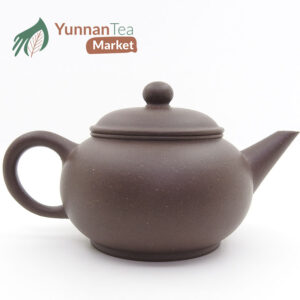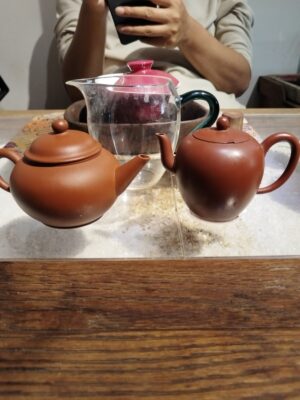-
×
 Large Bian Shuiping Teapot
1 × $205.00
Large Bian Shuiping Teapot
1 × $205.00
Zisha
Comparing the brewing result of Zisha teapots from different periods
Comparing the brewing result of Zisha teapots from different periods
How did we brew the tea?
To make it easier, avoid the heat retention factor, clay thickness difference and size of the teapot. We brew the tea in a Gaiwan, decant it on a pitcher, and then pour it into each teapot. You can leave the tea soup inside the teapots for a minute (a longer or shorter time) according to your preference.
The whole process and what we brewed
Today, I met with a friend to drink tea because I wanted to compare the result of brewing with two different Factory One teapots, one from the late 60s- 70s and the other from the early 90s.

Anyone who has conducted this type of test knows it is not practical. Additionally, accuracy-wise, ideally, you’d better have more than one person taste the brewed tea.
First, we tried some Sheng Puer. To my palate, the older teapot made the taste richer. Also more astringent. To my friend, the tea was sweeter in the older pot. I guess I was more focused on the astringency, so I didn’t notice the tea was significantly sweeter. Perhaps I had that feeling in the Shengjin, salivation, that felt slightly sweeter.
Then we tried some Yancha (Wulong). This time, the sweetness was more pronounced in the older teapot. Also, the taste was richer. Mouthfeel was softer. My friend had the same feeling. In the 90s teapot, the taste was not as sweet nor so rich.
Afterwards, my friend insisted on comparing the two teapots against a modern Si Ting Zhuni he had. We brewed another Sheng Puer tea he had.

At first, I was reluctant for two reasons. The first one, the clay material, was different. The two old teapots use Hongni, and the Siting uses Zhuni, so it is better to compare the same material.
My other reason not to do this test was that my friend’s teapot was well-seasoned. The older teapots had a similar amount of seasoning time when compared to each other, but they were less seasoned when compared to the Zhuni. Generally speaking, a well-seasoned pot makes better tea, so I didn’t want to do this comparison. But the result was a surprise in this particular case. Since both old teapots only have two weeks of seasoning.
Long story short, the older teapots make better tea than the more seasoned Zhuni. They had a sharper taste, less watery and slightly higher aroma.
Should one invest in older teapots solely to enhance the taste of the tea?
It depends. Some individuals new to drinking tea may not be able to discern a difference in taste. While there is an apparent distinction between older and newer pots (i.e. in this case, a 60s-70s and a 90s teapot) and an even greater contrast between older and modern pots, it is not significant. Hence, for beginners, the difference may not be readily noticeable.
But if you want to focus on improving taste and like to collect old teapots, go for it.
Note: In our comparison, perhaps against the Zhuni was more evident than when comparing the older teapots against each other.
So far, I have only addressed the taste effect because most people consider taste the most important aspect when using Zisha pots. However, other characteristics may interest those who appreciate old Zisha teapots.
A- Purity of the clay:
At present, it is not easy to find modern teapots without additives. In contrast, old teapots used pure clay without additives in them. That said, until now, I haven’t read any scientific study that shows that using a modern teapot with some additives, in particular, barium carbonate, which is used for different purposes in modern clay, one of them is to avoid Hua Ni spots in clay (look at the picture below), is harmful to the human body (in the amount used in a teapot). More research is needed. If someone has an article or a study about that, I would be more than willing to read it. If you kindly send it to me, I will read it and show it on this post.

Furthermore, there are other additives like colouring agents.
And I am sure there must be other chemicals I haven’t even heard of, so bear this in mind if you want a purer clay.
There is pure modern Zisha clay, but it’s not as easy to find as many would think.
B- Seasoning ability: Lastly, another thing to consider is the pot’s appearance transformation, something purely aesthetic. But as a tea drinker, observing how my teapot changes over time is rather pleasant.
It becomes darker, depending on what tea you brew in it, in colour and develops a beautiful patina. However, this transformation has some exceptions.
One is that in the past, some teapots from Factory One (and older teapots) were not fired to the right temperature. As a result, no matter how long you brew tea in the teapot. It won’t get shiny. I have observed this phenomenon in many Cultural Revolution teapots and even older pots made before Factory One.
Another factor is how you handle the teapot. That is, you need to learn how to season your pot the right way.
If you have a new teapot, and from the beginning, you start to rub it hard with a tea towel after each use. That is, without allowing the patina to build up for some time before you start rubbing it. You can forget about that nice-looking patina.
In my experience, referring to some modern teapots, this change in appearance is not as significant as with many old teapots. In contrast, many old teapots (but not all) gain patina effortlessly, even after a short brewing period.
Final thoughts:
Additionally, if you are taking up the tea hobby, one more thing to evaluate is how much money you want to spend because some old teapots are expensive.
Finally, a good Zisha clay pot won’t make a low-quality tea become a good one. If you want a good tea, buy a decent quality one. And be sure you are using spring water and not tap water. Then worry about what teaware to use.
I love Zisha pots, especially old Zisha teapots. However, I tried to write this post with a more objective viewpoint to assist neophytes.

